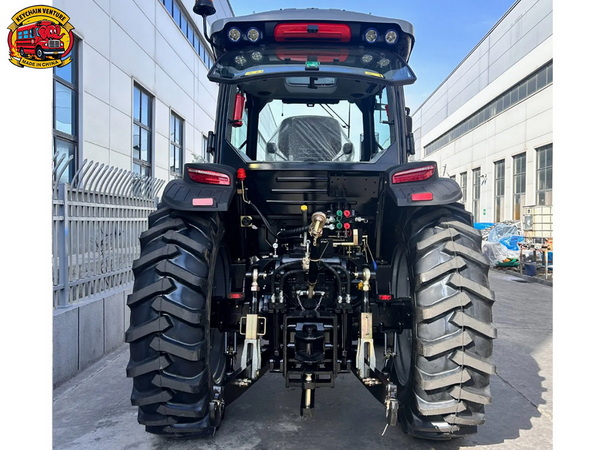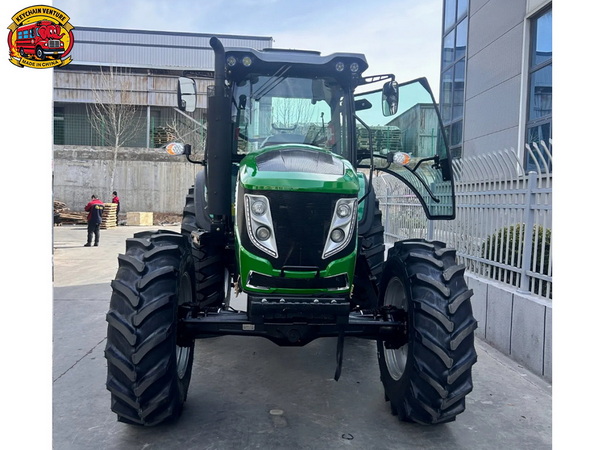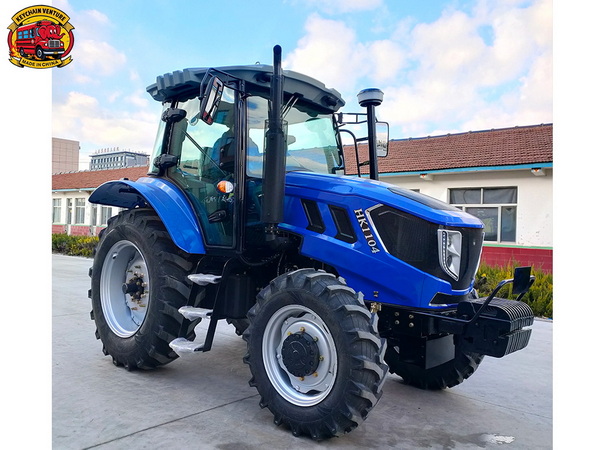Views: 222 Author: Amanda Publish Time: 2025-10-30 Origin: Site








Content Menu
● Construction and Design Principles
● Typical Tyre Weights for Different Tractor Classes
● The Science Behind Tyre Weight Selection
● How Tyre Weight Impacts Tractor Performance
● The Role of Tyre Weight in Tractor Applications
● Tyre Weight and Environmental Impact
● Innovations in Tractor Tyre Technology
● Handling, Installation, and Maintenance of Heavy Tyres
● Case Studies: Tractor Tyre Applications
>> Scenario One: Large-Scale Crop Farming
>> Scenario Two: Construction and Earthworks
>> Scenario Three: Mining and Heavy Haulage
● Tyre Weight Trends and Future Outlook
● Frequently Asked Questions (FAQ)
>> 1. How does tyre weight affect tractor stability?
>> 2. What is the recommended tyre weight for agricultural tractors?
>> 3. Do heavier tyres increase fuel consumption?
>> 4. Can lighter tyres improve soil health?
>> 5. Are tyre weights evolving with new technology?
KeyChain Venture Co., Ltd. stands as a leading supplier of high-performance commercial vehicles in China, offering innovative solutions for both domestic and global clients. Among the many components critical to efficient tractor operation, the tractor tyre remains an essential topic—its weight, design, and impact reverberating through farming, transportation, and infrastructure sectors.

Tractor tyres are more than simple rubber circles; they are complex, technologically advanced products engineered to withstand the rigors of varied terrains and intense workloads. A tractor relies on its tyres for traction, stability, and mobility, which means the proper selection and understanding of tyre characteristics—chiefly weight—play a vital role in agricultural and industrial applications.
The basic construction of a tractor tyre includes multiple layers of materials:
- Natural and Synthetic Rubber: The outer shell, designed to resist wear, punctures, and environmental damage.
- Steel Belting: These internal reinforcements provide structural integrity and allow the tyre to carry heavier loads.
- Fabric Ply (Nylon, Polyester): These layers add flexibility and toughness, enabling tyres to resist deforming under stress.
- Tread Patterns: Diverse configurations manage mud, rocks, snow, and uneven soil by channeling debris and maintaining grip.
The weight of a tractor tyre is determined not only by its dimensions but also by the materials and methods used in its manufacture. Advanced tyres may include composite fibers or chemical treatments for enhanced performance, directly affecting their mass.
The size and intended purpose of a tractor determine the weight range of the tyre it employs:
- Lawn and Garden Tractors: Tyres in this category are light and maneuverable, typically weighing between 15 and 30 kg. Ideal for residential landscaping, they provide adequate grip on grass and soft soil.
- Compact Utility Tractors: Transitioning into small-farm use, these require tyres ranging from 30 to 70 kg, balancing between durability and accessibility.
- Conventional Agricultural Tractors: Larger farm vehicles use tyres weighing 80 to 200 kg, optimized for heavy loads and persistent usage in demanding environments.
- Construction and Heavy-Duty Tractors: These can sport tyres from 200 kg up to 500 kg, built for rugged terrain and industrial strength.
- Mining, Earthmoving, and Forestry Tractors: The heaviest segment—here, individual tyres routinely surpass 500 kg and may reach or exceed 1,000 kg for extreme applications.
Tyre weight is a balance between necessity and efficiency. On soft, cultivated soil, tyres with significant mass excel in delivering uniform pressure and minimizing slippage. On the other hand, excessively heavy tyres can compact soil, making root growth difficult, affecting water retention, and potentially diminishing crop yields.
Farmers and fleet managers often consult with agricultural engineers to determine the optimum tyre weight for specific tasks. Parameters include tractor horsepower, anticipated field conditions, maximum payload, and the expected wear lifecycle for the tyre. Getting the balance right means better operational economics and sustainability over the long run.
Heavier tractor tyres generate more downward force, improving traction—especially in wet, muddy, or uneven conditions. This helps tractors maintain a steady course, reduces slippage, and enhances overall speed and productivity.
An increase in tyre weight often correlates with increased rolling resistance, which may lead to higher fuel consumption. However, the increased grip can offset this by allowing operators to work faster and more efficiently, sometimes reducing the number of passes needed in the field.
Heavier tyres mean improved stability on slopes and better counterweight for heavy attachments or trailers. Conversely, using inadequately weighted tyres can jeopardize safety through loss of control, premature wear, and potential breakdowns.

Whether a tractor is plowing fields, hauling loads, digging trenches, or clearing forests, the tyres must match the mechanical requirements and ground conditions.
- Agriculture: Uniform tyre weight distribution helps preserve soil health and maintain yields.
- Construction: Heavy tyres stabilize earthmoving equipment and prevent dangerous swaying or tipping.
- Forestry: Brute resilience and mass enable tractors to traverse rocky and root-laden terrain with safety and effectiveness.
- Mining: In extreme conditions, ultra-heavy tyres are engineered to withstand sharp debris and substantial payloads.
Modern agriculture increasingly prioritizes environmental sustainability. Tyre weight factors into eco-friendly practices because heavy compacting can degrade soil structure and reduce biodiversity. Leading manufacturers now offer flotation tyres that are both heavy and wide, dispersing the tractor's mass to minimize ground pressure.
Technicians and agronomists utilize ground-pressure calculators to evaluate the real-world impact of tyre weight and recommend adjustments that benefit both productivity and land stewardship.
Tractor tyre innovation is accelerating as global demands for efficiency and sustainability grow. Materials scientists are deploying new blends of polymers and resins, producing tyres that are lighter, longer-lasting, and more resistant to UV, chemicals, and punctures. Key advancements include:
- Radial Ply Design: Radial tyres feature flexible sidewalls and reinforced belts, making them lighter and more adaptable.
- Bio-Based Rubber: Some manufacturers use bio-derived compounds, reducing the environmental burden of synthetic production.
- Self-Sealing Liners: New lines include internal gel or foam layers that automatically seal small punctures, decreasing downtime and loss of performance.
KeyChain Venture Co., Ltd. integrates these leading-edge designs into its tractor fleet, ensuring that clients receive optimal performance and reliability.
Because tractor tyres often exceed human lifting capabilities, their handling requires specialized apparatus and protocols for technician health and safety.
- Hydraulic lifts, cranes, and forklifts ease the mounting and dismounting process.
- Pneumatic tools, bead expanders, and digital tire-pressure sensors ensure proper fit and alignment.
- Scheduled visual inspections, pressure checks, and tread-depth gauges help spot weaknesses before they cause operational failures.
Fleet managers train their crews in proper tyre management, knowing that a well-maintained tyre translates into fewer breakdowns, reduced repair costs, and maximized tractor uptime.
A KeyChain Venture Co., Ltd. client deployed 200 tractors on a major wheat farm. Engineers recommended 200 kg tyres with deep-lug, self-cleaning treads. The heavier mass provided outstanding stability in wet and soft loam, while minimizing rutting and aiding root health.
Highway construction teams fitted their 430-horsepower crawler tractors with 500 kg reinforced radial tyres. This allowed for uninterrupted operation on uneven gravel, reducing downtime and worker risk while maximizing earth-moving efficiency.
In South China, a mining operator required extreme resilience for vehicles hauling ore. Tyres weighing over 1,000 kg, featuring triple-belt steel reinforcement, enabled vehicles to transport multi-ton payloads across abrasive stone without loss of integrity.
Industry experts anticipate that the drive for sustainability and productivity will continue to define tractor tyre development. Advances in automation, real-time soil monitoring, and data-driven farm management are requiring tyres that strike an ever-sharper balance between mass, strength, and ecological impact.
Manufacturers like KeyChain Venture Co., Ltd. remain at the forefront, offering solutions that meet not only today's needs but also tomorrow's agricultural and logistical challenges.
The question "How heavy is a tractor tyre?" opens a window into a world of challenging technical decisions and nuanced engineering. Tyre weight varies widely, reflecting diverse agricultural, industrial, and environmental needs. By paying close attention to tyre selection, maintenance, and innovation, operators enhance safety, longevity, and sustainability. As tractor technology evolves, so will tyre design—shaping the future of global supply chains, commercial farming, and infrastructure development.

Heavier tyres increase a tractor's stability on slopes and uneven ground, reducing rollover risk and improving the effectiveness of heavy attachments.
The ideal weight depends on tractor type, field conditions, and application, but most farm tractors utilize tyres ranging from 80 kg to 200 kg for balanced performance.
While rolling resistance is greater with heavier tyres, added traction and reduced slippage can offset fuel costs when used efficiently and in suitable field conditions.
Lighter tyres cause less soil compaction, preserving root systems and soil structure, but may limit traction and durability in demanding applications. Flotation tyres provide a compromise—spreading weight while maintaining performance.
Yes, innovations in materials and design—including radial ply, bio-rubber, and composites—continually redefine tyre weight parameters for enhanced efficiency and environmental stewardship.